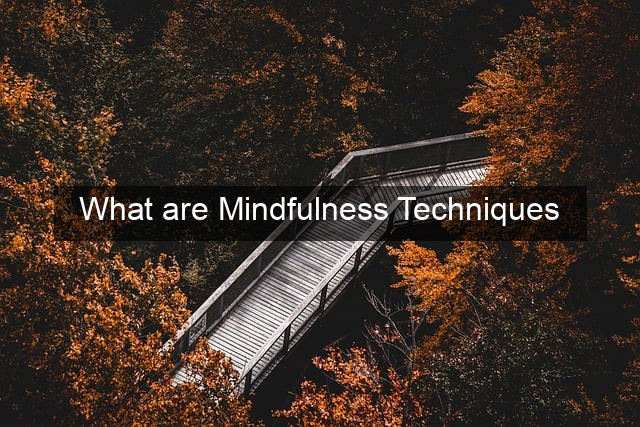What are Mindfulness Techniques?

- What are Mindfulness Techniques?
- Understanding Mindfulness
- What is Mindfulness?
- Why Practice Mindfulness?
- How to Get Started with Mindfulness
- Mindfulness Techniques for Everyday Life
- Mindful Breathing
- Body Scan Meditation
- Mindful Walking
- Mindfulness in Action
- Mindful Eating
- Mindful Listening
- Mindful Working
- Cultivating a Mindful Mindset
- Dealing with Difficult Emotions
- Creating a Mindful Space
- Integrating Mindfulness into Daily Life
- Resources for Mindfulness
- Online Resources
- Books on Mindfulness
- Local Mindfulness Centers
- Conclusion
- Frequently Asked Questions (FAQ)
- What is the difference between mindfulness and meditation?
- How long does it take to see the benefits of mindfulness?
- Do I have to sit in a specific posture to practice mindfulness?
- What if my mind wanders a lot during mindfulness practice?

What are Mindfulness Techniques?
In today’s relentlessly fast-paced world, achieving moments of tranquility and mental clarity can seem almost impossible. Our thoughts often race, consumed by anxieties about the future and regrets from the past. Mindfulness techniques offer a potent remedy to this incessant mental noise, equipping us with tools to ground ourselves in the present and foster a sense of peace and well-being. This article delves into various mindfulness techniques, illuminating their mechanisms and providing practical guidance for integrating them into your everyday life. Discover how to harness the power of mindfulness to alleviate stress, sharpen focus, and experience the present moment more fully.
Understanding Mindfulness
What is Mindfulness?
Mindfulness is the art of attending to the present moment without judgment. It entails observing your thoughts, emotions, and physical sensations without being swept away by them. This creates a valuable separation between you and your experiences, nurturing a sense of calm and clarity.
Why Practice Mindfulness?
The advantages of mindfulness are plentiful and extensively documented. Research indicates that consistent mindfulness practice can mitigate stress, improve sleep quality, enhance concentration, and even bolster the immune system. By cultivating a mindful approach to life, you can achieve better emotional regulation and develop resilience when confronted with adversity.
How to Get Started with Mindfulness
Embarking on a mindfulness journey is simpler than you might anticipate. No special equipment or significant time commitment is required. Even dedicating a few minutes daily can yield noticeable benefits. Start by selecting a quiet space free from distractions. Settle into a comfortable position and close your eyes if that feels right. Then, simply direct your attention to your breath, observing the sensation of each inhalation and exhalation.
Mindfulness Techniques for Everyday Life
Mindful Breathing
Mindful breathing serves as a cornerstone of mindfulness practice. It involves concentrating your attention on the feeling of your breath as it flows in and out of your body. When your mind wanders, gently redirect your focus back to your breath. This uncomplicated practice can be remarkably grounding and soothing.
Body Scan Meditation
A body scan entails methodically directing your attention to different areas of your body, observing any sensations without evaluation. This practice can cultivate a heightened awareness of your physical self and release any unconscious tension you might be holding.
Mindful Walking
Mindful walking is an excellent way to weave mindfulness into your daily routine. As you walk, focus on the sensation of your feet connecting with the ground. Observe the rhythm of your body’s movement and the surrounding sights and sounds. This practice can transform an ordinary walk into a contemplative experience.
Mindfulness in Action
Mindful Eating
Mindful eating involves fully engaging with the experience of eating, savoring every mouthful and appreciating the nuances of flavor and texture in your food. This practice can foster a healthier relationship with food and promote better digestion.
Mindful Listening
Mindful listening is centered on giving your undivided attention to the speaker, refraining from interruptions or prematurely formulating your response. It requires truly absorbing and comprehending what the other person is conveying. This practice can fortify relationships and enhance communication.
Mindful Working
Integrating mindfulness into your work can boost concentration and alleviate stress. Take short pauses throughout the day to practice mindful breathing or simply become aware of the sensations in your body. This can assist you in remaining present and engaged with your tasks.
Cultivating a Mindful Mindset
Dealing with Difficult Emotions
Mindfulness can empower you to navigate challenging emotions such as anger, sadness, and anxiety. By observing these emotions without judgment, you can establish a space between yourself and your reactions, enabling you to respond with greater wisdom and compassion.
Creating a Mindful Space
Designating a dedicated space for your mindfulness practice can be beneficial. This could be a tranquil corner in your home or a serene spot in nature where you feel at peace. Having a designated space can facilitate a regular practice.
Integrating Mindfulness into Daily Life
Weaving mindfulness into your daily life doesn’t need to be complex. Seek opportunities to incorporate mindfulness into everyday tasks such as brushing your teeth, washing dishes, or waiting in line. These small moments of awareness can accumulate over time, fostering a more mindful way of being.
Resources for Mindfulness
Online Resources
A wealth of online resources provide guided meditations, mindfulness exercises, and educational materials. Apps like Headspace and Calm offer structured programs for developing a mindfulness practice.
Books on Mindfulness
Many exceptional books explore the principles and practices of mindfulness. “Wherever You Go, There You Are” by Jon Kabat-Zinn is a seminal introduction to mindfulness, while “Full Catastrophe Living” offers a comprehensive guide to mindfulness-based stress reduction (MBSR).
Local Mindfulness Centers
Many communities have local mindfulness centers that offer classes, workshops, and retreats. These centers can provide invaluable support and guidance for your mindfulness path.
| Resource Type | Examples |
|---|---|
| Apps | Headspace, Calm, Insight Timer |
| Books | Wherever You Go, There You Are, Full Catastrophe Living |
- Practice mindful breathing for 5 minutes each day.
- Try a body scan meditation before bed.
- Incorporate mindful walking into your daily routine.
Conclusion
Mindfulness techniques provide practical and accessible methods for cultivating greater presence, diminishing stress, and bolstering overall well-being. By integrating these techniques into your daily life, you can learn to manage challenging emotions more effectively, enhance focus and concentration, and develop a deeper appreciation for the present moment. While the path of mindfulness may necessitate patience and persistence, the benefits are undoubtedly worth the effort. Start small, practice self-compassion, and uncover the transformative power of mindfulness.
As you embark on your mindfulness journey, keep in mind that it’s a continuous process of learning and growth. There will be times when your mind drifts, and that’s perfectly natural. Gently redirect your attention back to the present moment without judgment. With consistent practice, you’ll develop a heightened capacity for awareness and cultivate a more serene and fulfilling life.
Frequently Asked Questions (FAQ)
What is the difference between mindfulness and meditation?
Mindfulness is the state of being present and aware, while meditation is a formal practice that cultivates mindfulness. Meditation can be a potent tool for developing mindfulness, but mindfulness can also be practiced in everyday activities without formal meditation.
How long does it take to see the benefits of mindfulness?
Some individuals perceive benefits from mindfulness almost immediately, while others may require more time to experience significant changes. Consistency is paramount. Even a few minutes of daily practice can yield results over time.
Do I have to sit in a specific posture to practice mindfulness?
No, you don’t need to adopt a specific posture to practice mindfulness. You can practice mindfulness while sitting, standing, walking, or even lying down. The key is to find a position that is comfortable and allows you to remain alert and present.
What if my mind wanders a lot during mindfulness practice?
It’s entirely normal for your mind to wander during mindfulness practice. When you notice your mind wandering, simply gently redirect your attention back to your chosen focus, such as your breath or bodily sensations. Avoid self-criticism for having wandering thoughts. It’s an inherent part of the process.
